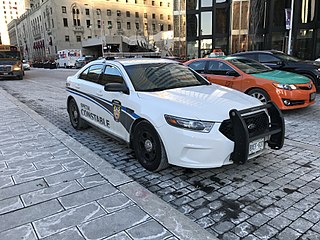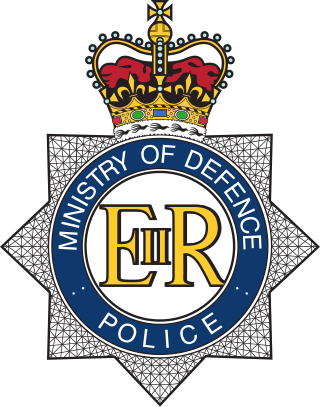
Military police (MP) are law enforcement agencies connected with, or part of, the military of a state. In wartime operations, the military police may support the main fighting force with force protection, convoy security, screening, rear reconnaissance, logistic traffic management, counterinsurgency, and detainee handling.

Law enforcement in the United Kingdom is organised separately in each of the legal systems of the United Kingdom: England and Wales, Northern Ireland and Scotland. Most law enforcement is carried out by police officers serving in regional police services within one of those jurisdictions. These regional services are complemented by UK-wide agencies, such as the National Crime Agency and the national specialist units of certain territorial police forces, such as the Specialist Operations directorate of the Metropolitan Police.

The Royal Military Police (RMP) is the corps of the British Army responsible for the policing of army service personnel, and for providing a military police presence both in the UK and while service personnel are deployed overseas on operations and exercises. Members of the RMP are often known as 'Redcaps' because of the scarlet covers on their peaked caps and scarlet coloured berets.

The Ministry of Defence Guard Service (MGS) is part of the Defence Infrastructure Organisation of the Ministry of Defence, it provides Defence establishments across the United Kingdom with guarding and patrol services and was established as a response to the Deal Bombing. The Guard Service is one of the few remaining uniformed Civil Service agencies within the UK, and has been named an elite guarding service within the United Kingdom. They provide the highest level of security to Defence assets supporting critical Defence assets.

The Royal Marines Police, or Royal Marines Police Troop is the Royal Marines element of the Royal Navy Police and the military police arm of the Royal Marines.

An authorised firearms officer (AFO) is a British police officer who is authorised and trained to carry and use firearms. The designation is significant because most police officers in the United Kingdom do not routinely carry firearms. The only forces where officers are routinely armed are the Police Service of Northern Ireland, the Ministry of Defence Police, the Civil Nuclear Constabulary, Belfast Harbour Police and the Belfast International Airport Constabulary.
A firearms unit is an armed unit within each territorial police force in the United Kingdom. For the most part, the police forces of the United Kingdom are unarmed; however, all have firearms units to provide the police force with the capability to deal with terrorists and armed criminals. A police officer cannot apply to join the firearms unit without first finishing their two-year probationary period, with a further two years in a core policing role for some forces. Firearms unit is the most common name outside of the capital, while that of London's Metropolitan Police Service is called the Specialist Firearms Command, Trojan or SC&O19. Within the media it is sometimes compared to the SWAT units of the United States.

The Belfast Harbour Police is a small, specialised ports police force, with responsibility for the Port of Belfast, Northern Ireland. It was founded in 1847, making it the oldest continuously-operating law enforcement agency on the island of Ireland.
Police uniforms and equipment in the United Kingdom vary enormously per force or service, and different uniforms and equipment is used for different situations. Both what is worn and what is carried have varied considerably from the inception of the earliest recognisable mainstream police services in the early 19th century. As various laws in the mid-19th century standardised policing in the United Kingdom, so too were uniforms and equipment. From a variety of home grown uniforms, bicycles, swords and pistols the British police force evolved in look and equipment through the long coats and top hat, to the recognisable modern uniform of a white shirt, black tie, reflective jackets, body armour, and the battenburg-marked vehicles, to the present-day Airwave Solutions radios, electric vehicles and tasers.

The Military Provost Guard Service (MPGS) is responsible for maintaining physical security at British Armed Forces locations throughout Great Britain. It is one of three constituent units of the Adjutant General's Corps Provost Branch. The Provost branch is the responsibility of the Provost Marshal who is a Brigadier from the Royal Military Police. The MPGS also works alongside the unarmed Ministry of Defence Guard Service (MGS). In Northern Ireland, armed security at Ministry of Defence establishments is provided by the uniformed civilian Northern Ireland Security Guard Service in a similar manner to that of the MPGS in Great Britain.
This is a description of law enforcement in Northern Ireland and the Republic of Ireland. Before the Republic left the union in 1922, one police force — the Royal Irish Constabulary — policed almost the whole island.
In the United Kingdom police firearm policy varies by constituent countries. In Northern Ireland, all police officers carry firearms whereas in the rest of the United Kingdom, firearms are carried only by specially-trained firearms officers. The arming of police in Great Britain is a much debated topic.
The Headquarters Mobile Support Unit (HMSU) is the police tactical unit of the Police Service of Northern Ireland. The HMSU was originally formed in the then Royal Ulster Constabulary part of Special Branch and was involved in several controversial shootings during The Troubles.
The Massereene Barracks shooting took place at Massereene Barracks in Antrim, Northern Ireland. On 7 March 2009, two off-duty British soldiers of 38 Engineer Regiment were shot dead outside the barracks. Two other soldiers and two civilian delivery men were also shot and wounded during the attack. A dissident Irish republican paramilitary group, the Real IRA, claimed responsibility.

In the United Kingdom, the term military police refers to the three branches of the service police. Often, the term 'military police' is considered synonymous with the Army's Royal Military Police, but in fact, has a wider context. There are a number of civilian police forces whose role is to police other parts of the Defence Estate in the UK and overseas, but such forces are not correctly referred to as military police.
The Ministry of Defence Police (MDP) in the United Kingdom can trace its origins back to 1686, and has gone through a number of evolutions over the centuries to achieve its present-day form. Until late 1965, the Royal Navy, British Army and Royal Air Force were controlled by separate departments: the Board of Admiralty, the Army Board and the Air Ministry respectively, each had its own Cabinet Minister. In that year it was decided that the three services should be placed under the control of one Minister of State for Defence, and the present Ministry of Defence was formed.

A special constable or special police constable can refer to an auxiliary or part-time law enforcement officer or a person who is granted certain (special) police powers.

The Ministry of Defence Police (MDP) is a civilian special police force which is part of the United Kingdom's Ministry of Defence. The MDP's primary responsibilities are to provide armed security and counter terrorism services to designated high-risk areas, as well as uniformed policing and limited investigative services to Ministry of Defence property, personnel, and installations throughout the United Kingdom. The MDP are not military police and should not be confused with the Royal Military Police or any other British Service Police. Service personnel often refer to the MDP by the nickname "MOD plod".











